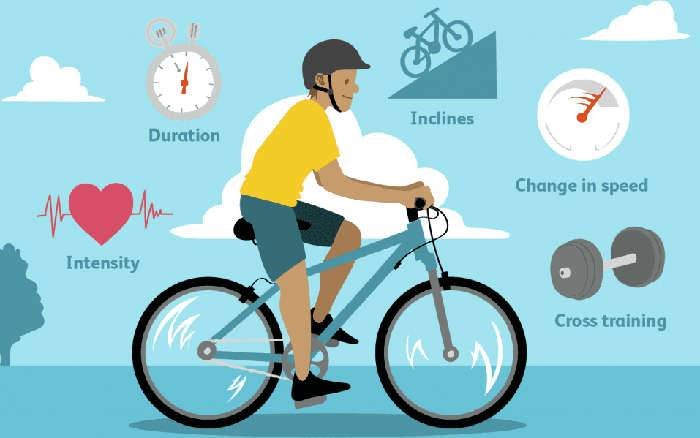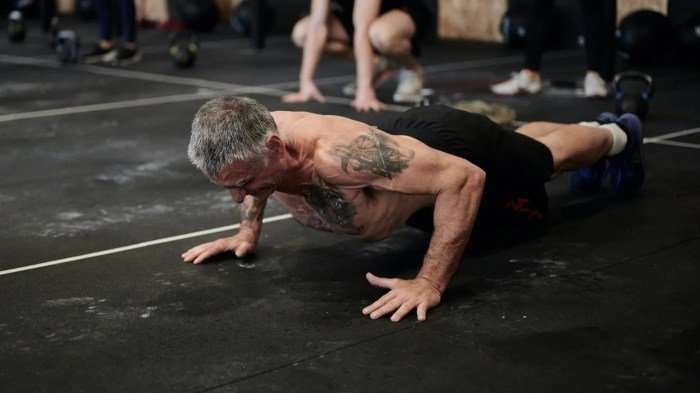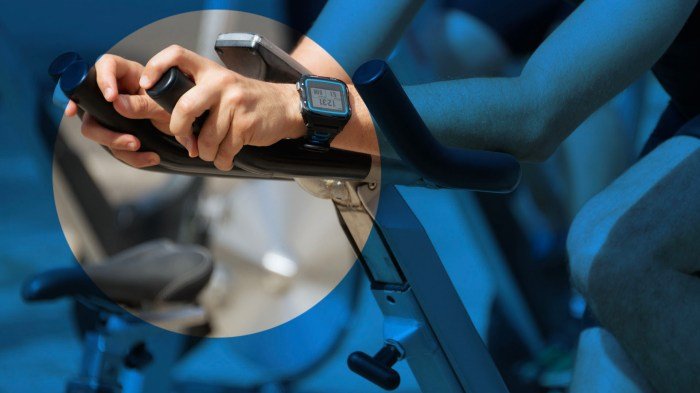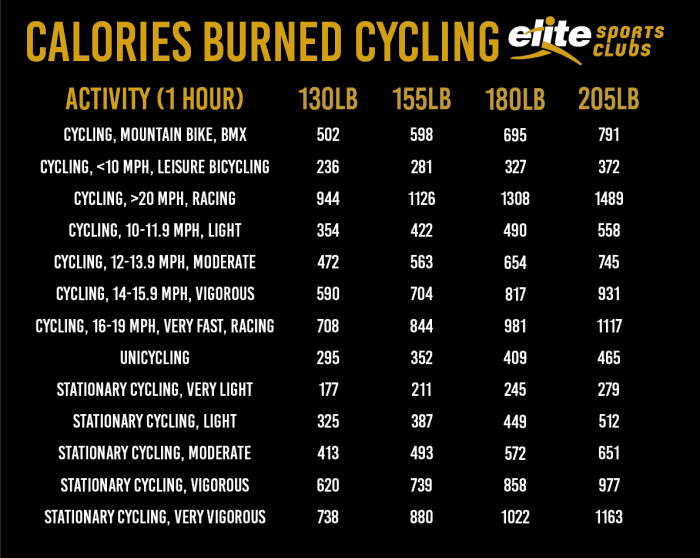Fitness bike calories burned is a topic that sparks curiosity among fitness enthusiasts, as they seek to understand how this popular exercise modality contributes to their health and weight management goals. Whether you’re a seasoned cyclist or a novice exploring the world of indoor cycling, knowing how many calories you burn on a fitness bike can be incredibly motivating.
This guide delves into the intricate relationship between fitness bikes and calorie expenditure, exploring factors that influence calorie burn, reliable estimation methods, and strategies for maximizing your workout’s effectiveness. We’ll cover everything from the different types of fitness bikes available to tips for designing a workout routine that helps you achieve your fitness goals.
Understanding Fitness Bikes

Fitness bikes are a popular choice for people looking to improve their cardiovascular health and fitness. They offer a low-impact workout that is easy on the joints and can be tailored to different fitness levels.
Types of Fitness Bikes
There are three main types of fitness bikes: stationary, spin, and recumbent. Each type has its unique features and benefits.
- Stationary bikesare the most common type of fitness bike. They have a stationary seat and handlebars, and the rider pedals against resistance. Stationary bikes are generally more affordable than other types of fitness bikes and are a good option for beginners.
- Spin bikesare similar to stationary bikes, but they have a heavier flywheel and a more challenging resistance. Spin bikes are often used in group fitness classes and are popular for high-intensity interval training (HIIT) workouts.
- Recumbent bikeshave a seat that is reclined, similar to a lounge chair. The handlebars are in front of the seat, and the rider’s legs are extended in front of them. Recumbent bikes are a good option for people with back pain or other injuries, as they provide more support and comfort.
Benefits of Using a Fitness Bike
Fitness bikes offer a number of benefits for your health and fitness, including:
- Improved cardiovascular health: Fitness bikes provide a cardiovascular workout that can help to strengthen your heart and lungs.
- Weight loss: Fitness bikes can help you burn calories and lose weight. The number of calories you burn will depend on your intensity and duration of your workout.
- Increased muscle strength: Fitness bikes work your leg muscles, including your quads, hamstrings, and calves.
- Low-impact workout: Fitness bikes are a low-impact exercise that is easy on your joints. This makes them a good option for people with arthritis or other joint problems.
- Convenience: Fitness bikes can be used in the comfort of your own home, making them a convenient option for people with busy schedules.
Popular Fitness Bike Brands and Models
There are many popular fitness bike brands and models on the market. Some of the most popular brands include:
- Peloton: Peloton is a popular brand known for its high-quality spin bikes and interactive fitness classes.
- NordicTrack: NordicTrack offers a variety of fitness bikes, including stationary bikes, spin bikes, and recumbent bikes.
- Schwinn: Schwinn is a well-known brand that offers a wide range of fitness bikes at different price points.
- Bowflex: Bowflex is known for its innovative fitness equipment, including its popular stationary bikes.
Factors Affecting Calories Burned

The number of calories you burn on a fitness bike is influenced by several factors. Understanding these factors can help you tailor your workouts to achieve your fitness goals.
Intensity
Intensity refers to how hard you are working during your workout. Higher intensity workouts burn more calories. You can increase the intensity of your workout by adjusting the resistance level on the bike.
Tracking your fitness bike calories burned can be a great way to stay motivated and see your progress. If you’re looking for a way to get even more detailed insights into your workouts, a fitness tracker like the fitness tracker whoop can be a valuable tool.
These trackers can monitor your heart rate, sleep patterns, and even your recovery time, providing a more comprehensive view of your fitness journey. With this information, you can optimize your training schedule and make sure you’re getting the most out of your fitness bike rides.
Duration
The longer you ride, the more calories you burn. This is a straightforward concept, but it’s important to note that the relationship between duration and calorie burn is not linear. Longer workouts may not necessarily burn proportionally more calories.
Weight
Your body weight plays a significant role in calorie burn. The heavier you are, the more calories you will burn. This is because you are moving more mass.
Metabolism
Metabolism refers to the rate at which your body burns calories. A higher metabolism will result in more calories burned during exercise. Factors like age, gender, and genetics can influence your metabolism.
Resistance Levels
Resistance levels on a fitness bike directly affect calorie expenditure. Higher resistance levels require more effort from your muscles, leading to increased calorie burn.
Higher resistance levels translate to more calories burned.
| Workout Duration | Intensity (Resistance Level) | Average Calories Burned |
|---|---|---|
| 30 minutes | Low | 200-250 |
| 30 minutes | Medium | 300-350 |
| 30 minutes | High | 400-450 |
| 60 minutes | Low | 400-500 |
| 60 minutes | Medium | 600-700 |
| 60 minutes | High | 800-900 |
Calorie Burn Estimation Tools

Estimating the calories burned during a fitness bike workout is important for tracking progress and achieving fitness goals. While it’s impossible to get a perfect measurement, various tools can provide a reasonable estimate. These tools utilize different methods to calculate calorie burn, each with its strengths and limitations.
The number of calories burned on a fitness bike can vary greatly depending on factors like intensity, duration, and your individual metabolism. If you’re looking for ways to boost your fitness journey, consider consulting the resources available at the Indiana University Health Center Bloomington.
They offer personalized guidance on exercise programs, nutrition, and overall well-being, which can help you effectively track your calorie burn and achieve your fitness goals.
Methods for Estimating Calorie Burn
Different methods are used to estimate calorie burn on a fitness bike, each with its own level of accuracy and reliability.
- Heart Rate Monitors:These devices measure your heart rate during exercise and use algorithms to estimate calorie burn based on your heart rate, age, weight, and gender. Heart rate monitors are generally considered more accurate than fitness trackers or online calculators because they directly measure your body’s effort.
- Fitness Trackers:Fitness trackers, such as smartwatches or fitness bands, often include calorie burn estimations. These devices typically use a combination of factors, including your steps, distance, and heart rate, to estimate calorie burn. However, their accuracy can vary depending on the device and the individual’s body composition.
- Online Calculators:Online calorie burn calculators are widely available and allow you to estimate calories burned based on factors like your weight, exercise duration, and intensity. These calculators typically use formulas based on metabolic equations and may provide a rough estimate. However, their accuracy is limited as they do not account for individual variations in metabolism and exercise efficiency.
Accuracy and Reliability of Estimation Methods
The accuracy of calorie burn estimation methods varies depending on the method used and individual factors.
- Heart rate monitorsare generally considered the most accurate method, but they are also the most expensive.
- Fitness trackerscan be less accurate, especially if they rely solely on movement data.
- Online calculatorsprovide a rough estimate but are not as reliable as heart rate monitors or fitness trackers.
Comparison of Calorie Burn Estimation Tools
Here’s a table comparing the features and limitations of popular calorie burn estimation tools:
| Tool | Features | Limitations |
|---|---|---|
| Heart Rate Monitor | Accurate calorie burn estimation, real-time heart rate monitoring, workout tracking, and data analysis. | Higher cost, requires wearing a chest strap, and may not be comfortable for all users. |
| Fitness Tracker | Affordable, convenient, tracks steps, distance, heart rate, and sleep, and provides calorie burn estimations. | Less accurate than heart rate monitors, relies on algorithms that may not be precise, and can be affected by factors like device type and user behavior. |
| Online Calorie Burn Calculator | Free and easily accessible, estimates calories burned based on weight, duration, and intensity. | Least accurate, does not account for individual variations in metabolism and exercise efficiency, and provides a general estimate rather than a personalized calculation. |
Maximizing Calorie Burn: Fitness Bike Calories Burned

Want to make your fitness bike workouts more effective and burn more calories? You can take your calorie burn to the next level by incorporating strategies that increase the intensity and duration of your workouts.
Knowing how many calories you burn on your fitness bike can be a great motivator, and it’s also important for tracking your overall health and fitness progress. Of course, understanding the legal framework surrounding healthcare is equally crucial, as it affects access to quality care and treatment.
Law and healthcare are intertwined in many ways, and it’s important to stay informed about these issues. Getting back to fitness, remember that calorie burn can vary based on your weight, intensity, and duration of your cycling sessions.
Interval Training, Fitness bike calories burned
Interval training is a highly effective way to boost calorie burn. This method involves alternating between high-intensity bursts and periods of rest or low-intensity recovery. The high-intensity intervals elevate your heart rate and challenge your cardiovascular system, leading to a significant increase in calorie expenditure.
- Example:A typical interval workout could involve 30 seconds of high-intensity pedaling followed by 30 seconds of rest or low-intensity pedaling. Repeat this cycle for 10-15 minutes.
High-Intensity Bursts
High-intensity bursts, also known as sprints, are short periods of intense effort that can significantly increase calorie burn. By pushing your limits for short intervals, you engage more muscle fibers and elevate your metabolic rate.
- Example:During a regular workout, incorporate 30-second sprints at the highest resistance level, followed by a 1-minute recovery period at a lower resistance level. Repeat this cycle 3-5 times.
Workout Routine
Here is a sample fitness bike workout routine that incorporates different intensity levels: Warm-up:5 minutes of light pedaling at a moderate resistance level. Interval Training:
- 30 seconds of high-intensity pedaling at a high resistance level (90% effort) followed by 30 seconds of rest or low-intensity pedaling.
- Repeat this cycle for 10 minutes.
High-Intensity Bursts:
- 30-second sprints at the highest resistance level followed by a 1-minute recovery period at a lower resistance level.
- Repeat this cycle 3 times.
Cooldown:5 minutes of light pedaling at a moderate resistance level.
Proper Form and Technique
Maintaining proper form and technique during your fitness bike workouts is crucial for maximizing calorie burn and preventing injuries. Proper form ensures that you engage the correct muscles and distribute effort efficiently.
- Engage Core Muscles:Keep your core muscles engaged throughout the workout to maintain stability and support your spine.
- Maintain Proper Posture:Keep your back straight, shoulders relaxed, and head in line with your spine. Avoid slouching or hunching over.
- Focus on Smooth Pedaling:Use a smooth and consistent pedaling motion, avoiding jerky or forceful movements.
- Adjust Resistance Levels:Adjust the resistance level to challenge yourself without compromising proper form.
Calorie Burn and Weight Loss

The number of calories you burn on your fitness bike is directly linked to weight loss. To shed pounds, you need to create a calorie deficit, meaning you burn more calories than you consume. This can be achieved through a combination of diet and exercise, and your fitness bike can play a significant role in this equation.
Calorie Deficit and Weight Loss
Creating a calorie deficit is essential for weight loss. This means burning more calories than you consume through a combination of diet and exercise. Your fitness bike can help you burn calories and contribute to your overall calorie deficit.
The general rule of thumb for weight loss is to aim for a calorie deficit of 500 calories per day. This can lead to a weight loss of about 1-2 pounds per week.
Example Calorie Deficit Plan
Here’s a sample calorie deficit plan incorporating fitness bike workouts:* Daily Calorie Intake:1,800 calories
Fitness Bike Workouts
3 sessions per week, 30 minutes each, burning approximately 300 calories per session.
Total Weekly Calorie Burn
900 calories
Total Weekly Calorie Deficit
1,500 calories (900 calories burned + 600 calories from diet)
Estimated Weekly Weight Loss
1.5
2 pounds
This is just an example, and your specific calorie intake and exercise needs will vary based on factors like your age, sex, weight, and activity level.
Staying Motivated and Consistent
Staying motivated and consistent with your fitness bike routine is crucial for achieving your weight loss goals. Here are some tips:* Set Realistic Goals:Don’t try to do too much too soon. Start with short sessions and gradually increase the duration and intensity as you get fitter.
Find a Workout You Enjoy
Choose a workout that you find enjoyable and engaging. This will make it easier to stick with your routine.
Track Your Progress
Keep track of your calorie burn, weight loss, and fitness improvements. This can help you stay motivated and see the results of your hard work.
Make It a Habit
Try to incorporate your fitness bike workouts into your daily routine. Schedule them in your calendar and treat them like any other important appointment.
Find a Workout Buddy
Having a workout buddy can provide motivation and support.
Reward Yourself
Reward yourself for reaching your fitness goals. This can help you stay motivated and on track.
Last Point

Understanding how many calories you burn on a fitness bike empowers you to make informed decisions about your workout routines. By considering the factors that influence calorie burn, utilizing accurate estimation tools, and employing effective strategies for maximizing calorie expenditure, you can unlock the full potential of your fitness bike workouts.
Remember, consistency is key, and a well-rounded approach that combines fitness bike workouts with a healthy diet and other forms of exercise will lead you to a healthier and more fulfilling lifestyle.
Essential Questionnaire
What are the best fitness bike brands for calorie burning?
Popular brands include Peloton, Echelon, NordicTrack, and Sunny Health & Fitness. Choosing the right brand depends on your budget, features, and personal preferences.
How often should I use a fitness bike for weight loss?
Aim for at least 3-4 sessions per week for optimal weight loss results. Combine this with a balanced diet and other forms of exercise for a holistic approach.
Are fitness bikes good for cardiovascular health?
Absolutely! Fitness bikes provide an excellent cardiovascular workout, strengthening your heart and improving blood circulation.
Can I use a fitness bike to tone my legs?
Yes, fitness bikes effectively target your leg muscles, enhancing strength and definition.